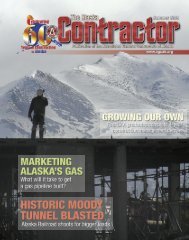New Mexico Minuteman - Summer 2011 - Keep Trees
New Mexico Minuteman - Summer 2011 - Keep Trees
New Mexico Minuteman - Summer 2011 - Keep Trees
Create successful ePaper yourself
Turn your PDF publications into a flip-book with our unique Google optimized e-Paper software.
By 1st Lt. Brian Raphael, 150th Fighter Wing Public Affairs Offi cer<br />
The 150th Fighter Wing, <strong>New</strong> <strong>Mexico</strong> Air<br />
National Guard, hosted the fi rst-ever Federal<br />
Emergency Management Agency regional<br />
training for Region 6 emergency managers<br />
in the Air National Guard. The one-week<br />
training held March 14-18, <strong>2011</strong>, at Kirtland<br />
Air Force Base had EM’s representing<br />
states from Region 6 — <strong>New</strong> <strong>Mexico</strong>, Texas,<br />
Oklahoma, Arkansas, and Louisiana.<br />
“This training prepares emergency<br />
managers to respond to all hazards on-<br />
and off-base,” said Senior Master Sgt. Matthew<br />
Archuleta, 150th Fighter Wing, <strong>New</strong><br />
<strong>Mexico</strong> Air National Guard. “All hazards<br />
including chemical, biological, radiological,<br />
nuclear, and high-yield explosives in<br />
active CBRNE.”<br />
“This Region 6 training is the fi rst time<br />
we brought together all bases within the<br />
region,” said Tech. Sgt. Robby McGee,<br />
Fort Smith, Ark. “Training is designed for<br />
profi ciency, protective equipment, hazard<br />
identifi cation, sharpening skills. It is a<br />
yearly requirement in compliance with<br />
OSHA and Air Force instructions.”<br />
The training exercise was broken down<br />
into two portions. The classroom portion<br />
spanned three days at the Defense<br />
Threat Reduction Agency. There a detailed<br />
table-top exercise composed of a notional<br />
dirty bomb scenario was introduced and<br />
responded to by emergency managers,<br />
military and civil authorities with a focus on<br />
command, control, and coordination.<br />
The second portion of the training was<br />
application focused and covered in two<br />
days. This fi eld application incorporated the<br />
Joint Effect Modeling — a contamination<br />
plume modeling program, and one Accident<br />
Coordination Response scenario identifying<br />
ricin and industrial chemical hazards.<br />
“This is a good opportunity to merge<br />
people who are not trained and don’t have<br />
their own equipment with people who are<br />
trained and have the equipment,” said<br />
Senior Airman Robert Clopton, 136th Air Lift<br />
Wing, Fort Worth, Texas. “Every Emergency<br />
Manager must have a medical and physical<br />
check and be physically fi t because of all<br />
the protective gear that must be worn while<br />
working inside a level-A suit.”<br />
While providing protection from certain<br />
hazards, the level-A suit itself is cumbersome<br />
and challenging to work in. “It’s<br />
kinda like your personal sauna,” said<br />
Senior Airman Jessica Keal, Naval Air<br />
Station Joint Reserve Base, Fort Worth,<br />
Texas. Keal is also a full-time nuclear plant<br />
employee whose family works for FEMA.<br />
This groundbreaking event leverages<br />
the many strengths of Region 6 emergency<br />
managers while identifying possible<br />
areas of improvement. In the future, different<br />
installations within Region 6 will host<br />
similar events to bring profi ciency training<br />
to everyone who otherwise might not be<br />
Members from FEMA Region 6 Managers<br />
descend on <strong>New</strong> <strong>Mexico</strong> for a fi rst-ever<br />
regional training.<br />
One member of FEMA Region 6 trainees suits<br />
up in a Level-A chemical protection suit while<br />
the other Airman checks the gauge to ensure it<br />
is reading the oxygen levels properly. Both of<br />
the members must receive this training as it is a<br />
yearly requirement. The Level-A chemical protection<br />
suit, along with an oxygen tank and bright<br />
orange rubber boots, are just some of the equipment<br />
they must be fully trained on for emergencies<br />
that may arise. All of the units proved to<br />
work well together during the training. Photos:<br />
Master Sgt. Paula Aragon<br />
able to travel to one location. In addition,<br />
the different venues will aid the training<br />
by providing an unfamiliar environment.<br />
Should the need ever arise, emergency<br />
managers will have the training, familiarity,<br />
and profi ciency required to neutralize<br />
potential hazards.<br />
<strong>Summer</strong> <strong>2011</strong> / NEW MEXICO National Guard 11

















